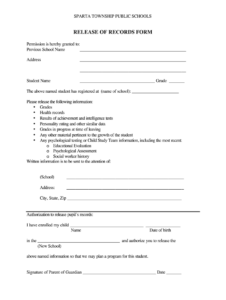Utilizing a pre-designed form offers numerous advantages. It streamlines the retrieval process, reduces ambiguity in requests, and promotes compliance with data privacy regulations. Furthermore, it saves time and resources for both the requester and the record keeper, contributing to a more efficient and organized system for managing sensitive information.
Understanding the purpose and benefits of such a structured approach provides a foundation for exploring specific use cases, legal considerations, and best practices for implementation. The following sections will delve deeper into these critical aspects.
Key Components of an Employee Record Request Form
Effective forms for requesting personnel data require specific elements to ensure clarity, completeness, and efficient processing. The following components are essential:
1. Requestor Information: Full name, employee ID, department, and contact information are crucial for identifying the individual making the request and enabling follow-up communication.
2. Subject Employee Information: Full name and employee ID of the individual whose records are being requested are necessary to accurately identify the correct file.
3. Specific Records Requested: A clear and detailed description of the specific documents or information required ensures the request is properly fulfilled. This might include performance reviews, salary information, attendance records, or other relevant data.
4. Purpose of Request: Stating the reason for the request helps determine its legitimacy and relevance, and may be necessary for compliance with privacy regulations.
5. Date of Request: Recording the date helps track processing time and ensures timely fulfillment.
6. Authorization (if applicable): Depending on the sensitivity of the information requested, a signature or other form of authorization might be required from a supervisor or manager.
7. Signature of Requestor: This confirms the requestor’s identity and agreement to any terms and conditions related to accessing personnel records.
Careful inclusion of these components facilitates efficient and accurate processing, ensuring that requests are handled correctly and in compliance with relevant regulations while maintaining data security.
How to Create an Employee Record Request Form
Developing a standardized form for requesting employee records involves careful consideration of key elements and legal compliance. A well-designed form facilitates efficient processing, ensures clarity, and protects sensitive information. The following steps outline the process:
1. Define the Purpose and Scope: Determine the types of employee records that can be requested through the form and the intended users. This clarifies the scope and ensures the form meets specific organizational needs.
2. Identify Required Information: Determine the essential data points to be collected on the form, such as requestor and employee identification, specific records requested, purpose of the request, and authorization (if required).
3. Design the Form Layout: Create a clear and user-friendly layout with distinct sections for each data category. Use clear labels and instructions to guide users through the completion process.
4. Incorporate Legal and Compliance Requirements: Ensure the form adheres to relevant data privacy regulations and internal policies. Consult with legal counsel to address any specific legal requirements regarding data access and disclosure.
5. Establish a Review and Approval Process: Define a workflow for reviewing and approving requests. This may involve managerial approval or verification of the requestor’s identity.
6. Implement and Communicate: Introduce the new form through appropriate channels, such as company intranet or email announcements. Provide clear instructions on how to use and submit the form.
7. Regularly Review and Update: Periodically review the form’s effectiveness and make updates as needed to reflect changing regulations, company policies, or user feedback. This ensures the form remains relevant and compliant.
A thoughtfully designed form, coupled with a clear process for submission and review, enables efficient and compliant access to employee records while safeguarding sensitive information. This structured approach benefits both employees and the organization by streamlining requests and promoting responsible data handling.
Standardized forms for accessing personnel data provide a crucial framework for managing sensitive information. These forms ensure clarity, consistency, and efficiency in the request process, benefiting both employees seeking access to their own records and the organizations responsible for maintaining data integrity. Key components, such as clear identification of the requestor and the specific records sought, coupled with a well-defined purpose for the request, are essential elements of a comprehensive form. Adherence to legal and compliance requirements is paramount, ensuring that access to personnel data aligns with data privacy regulations and internal policies. A robust review and approval process further strengthens the framework, safeguarding sensitive information while facilitating legitimate access.
Effective management of employee data is a critical aspect of organizational responsibility. Implementing standardized request procedures through well-designed forms contributes significantly to this objective. This structured approach not only streamlines processes and improves efficiency but also fosters a culture of transparency and compliance. Continued review and refinement of these procedures are essential to adapt to evolving regulations and best practices, ensuring responsible and ethical handling of personnel information.

